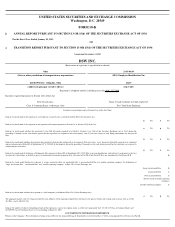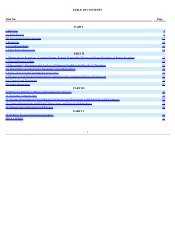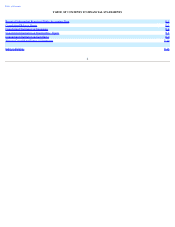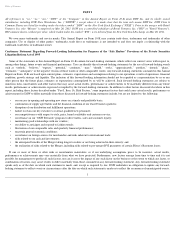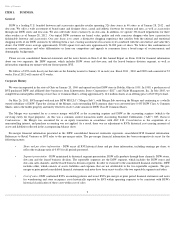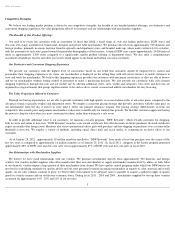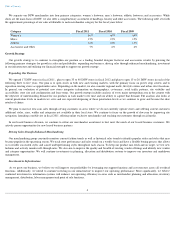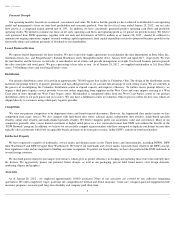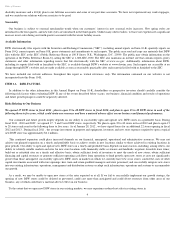DSW 2011 Annual Report Download - page 12
Download and view the complete annual report
Please find page 12 of the 2011 DSW annual report below. You can navigate through the pages in the report by either clicking on the pages listed below, or by using the keyword search tool below to find specific information within the annual report.
Table of Contents
those markets. As our store base increases, our stores will become more concentrated in the markets we serve. As a result, the number of customers
and financial performance of individual stores may decline and the average sales per square foot at our stores may be reduced. This
could have a
material adverse effect on our business.
We have entered into Supply Agreements with Stein Mart and Gordmans. If Stein Mart or Gordmans were to terminate our supply agreements,
close a significant number of stores or liquidate, it could have a material adverse effect on our business and financial performance.
Our supply agreements are typically for multiple years with automatic renewal options as long as either party does not give notice of intent not to
renew. For Stein Mart and Gordmans, our contractual termination dates are December 2014 and January 2013
, respectively. In addition, the
agreements contain provisions that may trigger an earlier termination. For fiscal 2011
, the sales from our leased business division represented
approximately 7.5%
of our total company sales. In the event of the loss of either of these leased supply agreements, it is unlikely that we would be able
to proportionately reduce expenses to the reduction of sales.
The performance of our leased businesses is highly dependent on the performance of Stein Mart and Gordmans. If Stein Mart or Gordmans were to
terminate our supply agreements, close a significant number of stores or liquidate, it could have a material adverse effect on our business.
We rely on our good relationships with vendors to purchase brand name and designer merchandise at favorable prices. If these relationships were
to be impaired, we may not be able to obtain a sufficient assortment of merchandise at
attractive prices, and we may not be able to respond
promptly to changing
fashion trends, either of which could have a material adverse effect on our business and financial performance.
We generally do not have long-
term supply agreements or exclusive arrangements with any vendors and, therefore, our success depends on
maintaining good relationships with our vendors. Our growth strategy depends to a significant extent on the willingness and ability of our vendors to
supply us with sufficient inventory to stock our stores. If we fail to maintain our relationships with our existing vendors or to enhance the quality of
merchandise they supply us, and if we cannot maintain or acquire new vendors of in-
season brand name and designer merchandise, our ability to
obtain a sufficient amount and variety of merchandise at favorable prices may be limited, which could have a negative impact on our business. In
addition, our inability to stock our sales channels with in-
season merchandise at attractive prices could result in lower net sales and decreased customer
interest in our sales channels, which could have a material adverse effect on our business.
Further, if our merchandise costs increase due to increase
material or labor costs, or other reasons, our ability to respond or the effect of our response could adversely affect our net sales or gross profit.
During fiscal 2011 , merchandise supplied to DSW by three key vendors accounted for approximately 19%
of our net sales. The loss of or a
reduction in the amount of merchandise supplied by any one of these vendors could have an adverse effect on our business.
We may be unable to anticipate and respond to fashion trends and consumer
preferences in the markets in which we operate, which could have a
material adverse effect on our business.
Our merchandising strategy is based on identifying each region’
s customer base and having the proper mix of products in each store to attract our
target customers in that region. This requires us to anticipate and respond to numerous and fluctuating variables in fashion trends and other conditions
in the markets in which our stores are situated. A variety of factors will affect our ability to maintain the proper mix of products in each store,
including: variations in local economic conditions, which could affect our customers’ discretionary spending and their price sensitivity;
unanticipated
fashion trends; our success in developing and maintaining vendor relationships that provide us access to in-
season merchandise at attractive prices; our
success in distributing merchandise to our stores in an efficient manner; and changes in weather patterns, which in turn affect consumer preferences.
If we are unable to anticipate and fulfill the merchandise needs of each region, we may experience decreases in our net sales and may be forced to
increase markdowns in relation to slow-moving merchandise, either of which could have a material adverse effect on our business.
Our operations are affected by seasonal variability.
Our business is subject to seasonal merchandise trends when our customers’
interest in new seasonal styles increases. New spring styles are
introduced in the first quarter, and new fall styles are introduced in the third quarter. As a result of seasonal merchandise trends, any factors negatively
affecting us during these periods, including adverse weather, the timing and level of markdowns, fashion trends or unfavorable economic conditions,
could have a material adverse effect on our business.
7


